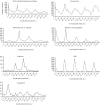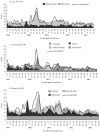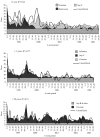Investigating the aetiology of and evaluating the impact of the Men C vaccination programme on probable meningococcal disease in England and Wales
- PMID: 16492318
- PMCID: PMC2870486
- DOI: 10.1017/S0950268806005991
Investigating the aetiology of and evaluating the impact of the Men C vaccination programme on probable meningococcal disease in England and Wales
Abstract
The aims were to (1) investigate the aetiology of probable meningococcal disease, where a clinical diagnosis is made in the absence of laboratory data, and (2) evaluate the impact of the Men C vaccination programme in England and Wales. Multiple linear regression analyses were carried out using data reported to Enhanced Surveillance of Meningococcal Disease (ESMD) and laboratory reports of isolates of organisms causing symptoms that mimic meningococcal disease. Confirmed meningococcal disease appeared to be a significant predictor of probable disease. Thus, an additional reduction in meningococcal disease attributable to the serogroup C vaccination campaign was evident in probable disease over and above that observed in confirmed cases alone. Enteroviruses were a significant contributor to cases of probable meningitis and influenza appeared to be a significant contributor to probable cases of septicaemia. This analysis confirms the success seen following the Men C vaccination campaign and gives an indication of the aetiologies of other causes of probable meningitis and septicaemia reported to ESMD.
Figures





Similar articles
-
Estimating the burden of serogroup C meningococcal disease in England and Wales.Commun Dis Public Health. 2002 Sep;5(3):213-9. Commun Dis Public Health. 2002. PMID: 12434691
-
Enhanced surveillance scheme for suspected meningococcal disease in five regional health authorities in England: 1998.Commun Dis Public Health. 2002 Sep;5(3):205-12. Commun Dis Public Health. 2002. PMID: 12434690
-
Meningococcal serogroup C conjugate vaccination in England and Wales: coverage and initial impact of the campaign.Commun Dis Public Health. 2002 Sep;5(3):220-5. Commun Dis Public Health. 2002. PMID: 12434692
-
Meningococcal C conjugate vaccine: the experience in England and Wales.Vaccine. 2009 Jun 24;27 Suppl 2:B20-9. doi: 10.1016/j.vaccine.2009.04.067. Epub 2009 May 23. Vaccine. 2009. PMID: 19477053 Review.
-
New frontiers in meningococcal vaccines.Expert Rev Vaccines. 2011 May;10(5):617-34. doi: 10.1586/erv.11.50. Expert Rev Vaccines. 2011. PMID: 21604983 Review.
Cited by
-
Estimating true hospital morbidity of complications associated with mumps outbreak, England, 2004/05.Euro Surveill. 2016 Aug 18;21(33):30320. doi: 10.2807/1560-7917.ES.2016.21.33.30320. Euro Surveill. 2016. PMID: 27562958 Free PMC article.
-
Using linked birth, notification, hospital and mortality data to examine false-positive meningococcal disease reporting and adjust disease incidence estimates for children in New South Wales, Australia.Epidemiol Infect. 2015 Sep;143(12):2570-9. doi: 10.1017/S0950268814003355. Epub 2015 Jan 9. Epidemiol Infect. 2015. PMID: 25573266 Free PMC article.
-
Multiple Linear Regression Model of Meningococcal Disease in Ukraine: 1992-2015.Comput Math Methods Med. 2020 Feb 11;2020:5105120. doi: 10.1155/2020/5105120. eCollection 2020. Comput Math Methods Med. 2020. PMID: 32104202 Free PMC article.
References
-
- Health Protection Agency http://www.hpa.org.uk/infections/topics_az/meningo/backgrd.htm. http://www.hpa.org.uk/infections/topics_az/meningo/backgrd.htm . Background information – Meningitis ( ). Accessed 29 September 2005.
-
- Chief Medical Officer, Chief Nursing Officer, Chief Pharmaceutical Officer London: Department of Health; 1999. . Introduction of immunisation against group C meningococcal infection (PL/CMO/99/2, PL/CNO/99/4, PL/CHO/99/1),
-
- Communicable Disease Surveillance Centre. Vaccination programme for group C meningococcal infection is launched. Communicable Disease Report Weekly. 1999;9:261. - PubMed
-
- Trotter CL, Ramsay ME, Kaczmarski EB. Meningococcal serogroup C conjugate vaccination in England and Wales: coverage and initial impact of the campaign. Communicable Disease and Public Health. 2002;5:220–225. - PubMed
-
- Kaczmarski EB et al. Creating a national service for the diagnosis of meningococcal disease by polymerase chain reaction. Communicable Disease and Public Health. 1998;1:54–56. - PubMed
MeSH terms
Substances
LinkOut - more resources
Full Text Sources
Medical

